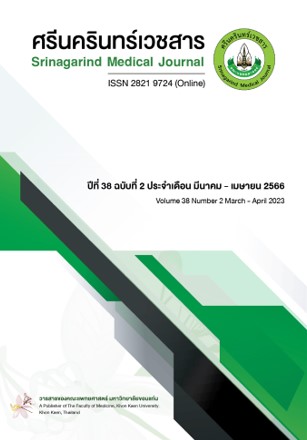Evaluation of Scan-Initiating Techniques of Arterial Phase in CT Triple-Phase Liver Scan in Patients with Hepatocellular Carcinomas
Keywords:
triple- phase CT, arterial phase, fixed time delay, bolus trackingAbstract
Background and objectives: The methods of initiating arterial (A) phase scans in triple- phase CT of abdomen (liver ) in patients with hepatocellular carcinomas (HCCs) are important. Starting a scan at the right time will clearly reveal the extent of the diseases. This study evaluated the A phase scanning initiation techniques in comparison between bolus tracking (BT) and fixed time delay (FTD) techniques.
Methods: A qualitative study was performed by questionnaires asking opinions of 9 radiologists, with 8 radiologists responded on CT triple- phase liver images quality. And a retrospective study was done to review CT images of A phase scanning by BT and FTD techniques of patients with HCCs on radiographic database, 100 cases per group. The images obtained by 128- slice MDCT scanner, with IV contrast media 555 mg I/kg body weight, contrast injection rate 1.8- 2.5 ml/sec, FTD technique started scanning at 30-45 seconds after contrast media administration. CT number (HU) measurements were done at aorta, portal vein and liver parenchyma, presented value as percent, range and mean (SD).
Results: Radiologists had a high level of satisfaction on the triple phase liver CT images (4/5), but the A phase images were uneven, subtle enhancement, and started scanning too early. The retrospective study showed that A phase images of both methods yielded indifferent aortic attenuation. Liver enhancement of FTD technique (15.48±9.66 HU) was significantly higher than that of BT technique (12.11±7.70 HU), p <0.01 by t-test. The mean scan- initiating time of the BT technique was 35.5 ± 5.9 (24-51) sec. The A phase images of both techniques were mostly under criteria standards, with 20-30 HU liver enhancement being only 27% and 17% among the groups FTD and BT, respectively.
Conclusion: The initiation of the A phase scan in triple- phase CT of the liver in patients with HCCs by both techniques yielded mostly suboptimal enhancement images and should be improved.
References
Screening guidelines diagnose and treat cholangiocarcinoma [Internet]. [cited July 23, 2022], Available from: https://www.nci.go.th/th/cpg/download%20Liver/01.pdf
Chernyak V, Fowler KJ, Kamaya A, Kielar AZ, Elsayes KM, Bashir MR et al. Liver imaging reporting and data system (LI-RADS) Version 2018: Imaging of Hepatocellular Carcinoma in At-Risk Patients. Radiology 2018;289(3):816-30.doi.org/10.1148/radiol.2018181494
American College of Radiology. LI-RADS® Technique - Chapter 12 [Internet]. [cited July 23, 2022], Available from: https://www.acr.org/-/media/ACR/Files/Clinical-Resources/LIRADS/Chapter-12-Technique.pdf?la=en&hash=3B774BD8A6D0A6ACBD62B2330705FD14
Yamashita Y, Komohara Y, Takahashi M, Uchida M, Hayabuchi N, Shimizu T, et al. Abdominal helical CT: evaluation of optimal doses of intravenous contrast material-a prospective randomized study. Radiology 2000;216:718-23. doi.org/10.1148/radiology.216.3.r00se26718
Eddy K, Costa AF. Assessment of cirrhotic liver enhancement with multiphasic computed tomography using a faster injection rate, late arterial phase, and weight-based contrast dosing. Can Assoc Radiol J 2017;68(4):371-8. doi.org/10.1016/j.carj.2017.01.001
Adibi A, Shahbazi A. Automatic bolus tracking versus fixed time-delay technique in biphasic multidetector computed tomography of the abdomen. Iran J Radiol 2014;11(1):e4617.
doi.org/10.5812/iranjradiol.4617
Fujigai T, Kumano S, Okada M, Hyodo T, Imaoka I, Yagyu Y, et al. Optimal dose of contrast medium for depiction of hypervascular HCC on dynamic MDCT. Eur J Radiol 2012;81(11):2978-83. doi.org/10.1016/j.ejrad.2012.01.016
Mehnert F, Pereira PL, Trübenbach J, Kopp AF, Claussen CD. Biphasic spiral CT of the liver: automatic bolus tracking or time delay? Eur Radiol 2001;11(3):427-31. doi.org/10.1007/s003300000633
Chiu RY, Yap WW, Patel R, Liu D, Klass D, Harris AC. Hepatocellular Carcinoma Post Embolotherapy: Imaging Appearances and Pitfalls on Computed Tomography and Magnetic Resonance Imaging. Can Assoc Radiol J 2016;67(2):158-72. doi.org/10.1016/j.carj.2015.09.006
Matsui Y, Horikawa M, Jahangiri Noudeh Y, Kaufman JA, Kolbeck KJ, Farsad K. Baseline Tumor Lipiodol Uptake after Transarterial Chemoembolization for Hepatocellular Carcinoma: Identification of a Threshold Value Predicting Tumor Recurrence. Radiol Oncol 2017;51(4):393-400. doi.org/10.1515/raon-2017-0030
Awai K, Hori S. Effect of contrast injection protocol with dose tailored to patient weight and fixed injection duration on aortic and hepatic enhancement at multidetector-row helical CT. Eur radiol 2003;13(9):2155-60. doi.org/10.1007/s00330-003-1904-x
Yamaguchi I, Kidoya E, Suzuki M, Kimura H. Optimizing scan timing of hepatic arterial phase by physiologic pharmacokinetic analysis in bolus-tracking technique by multi-detector row computed tomography. Radiol Phys Technol 2011;4(1):43-52.doi.org/10.1007/s12194-010-0105-y
Downloads
Published
How to Cite
Issue
Section
License
Copyright (c) 2023 Srinagarind Medical Journal

This work is licensed under a Creative Commons Attribution-NonCommercial-NoDerivatives 4.0 International License.




